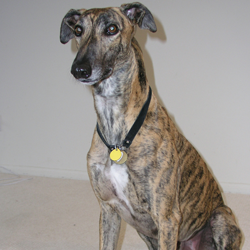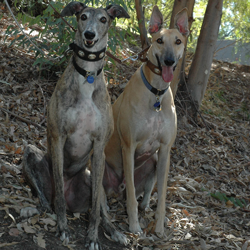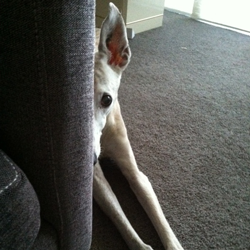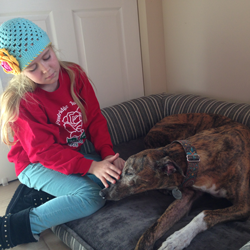TRAINING - BEHAVIOR: Destruction & Chewing

You may never face the following behavior problems with your dog. If you do, however, realize that these behaviors are not the mark of a criminal dog. They simply represent either normal canine behavior (needing a more human approved outlet) or behavior brought about by a lack of self-confidence or security on the part of your dog (which will cure itself with love, patience, and a little work on your part).
Destruction
A frustrating situation occurs when the dog does something wrong while the owner is absent. It is frustrating because you may never punish a dog unless you witness him in the act itself.
Communication between dogs and humans is delicate. For example, your dog has chewed the leg of an expensive chair. You yell. Does your dog perceive, “my owner is mad because I chewed the one leg” or “my owner is mad because I didn’t chew all four chair legs?”
Uninformed people say, “I know my dog understands because he or she has a guilty look when I return.” That “guilty look” does not come from the realization that chewing the chair leg was wrong. It comes from reading your verbal and nonverbal cues that something is wrong.
Punishing the dog when you return and find a mistake teaches the dog that “being left alone precedes getting punished.” Obviously being left alone then causes even more anxiety, which causes your dog to become more destructive. It is far better to prevent problems rather than punish the dog.
Work through the same steps that were listed under separation anxiety. They will help you have a secure, nondestructive family member. Remember, patience and persistence (once again) are the keys. Your dog will grow to understand that you do come home every day and that the time alone is not a cause for anxiety.
Chewing
Chewing is a natural, normal canine behavior. Once dogs are adults, the main cause of chewing is to alleviate stress and boredom. Unfortunately for dogs, humans usually think of chewing as a sign of misbehavior. The solution actually comes in the form of compromise between human and dog; you learn to provide appropriate outlets for this inbred behavior, and the dog learns to use only those outlets.
The easiest way to deal with chewing is to provide a wide variety of chew toys for your dog. Check your local pet store for a broad selection; and, as with children’s toys, make certain there are no removable parts which could come loose and injure your dog. The toys themselves don’t have to be new, just frequently interchanged.
• Try filling a paper (not plastic) lunch bag with 1 or 2 toys and broken up treats, fold over the top and offer it to your dog as a gift when you depart. This is fun for your dog and offers hours of entertainment with the bag and its contents. The toy bag is a pleasant and positive solution which you’ll find to be easy on both of you. Wouldn’t you rather pick up the remnants of a small paper bag than the garbage bag or perhaps your couch?
• Kong® toys, Buster Cubes®, and other “fillable” toys provide great entertainment for your dog. Put a few pieces of broken up treats or dog food and/or peanut butter inside the toy for him or her to “dig out.”
Store a variety toys in one spot so your dog can learn where to go to select an appropriate chew toy. A basket in the corner is a good choice. Begin by showing the dog where the toys are located. When you find your dog chewing on an inappropriate item, trade it for a toy out of the basket; then praise profusely. He or she will get the message you’re sending– it’s much more fun to chew on the toys and get praised than to chew on other things.
Is your dog bored?
Separation anxiety, chewing, and destruction can also signal that your dog is bored. For some ideas to stimulate your dog’s mind, read this article.
by Bonnie Jeffers, GreySave volunteer
Destruction
A frustrating situation occurs when the dog does something wrong while the owner is absent. It is frustrating because you may never punish a dog unless you witness him in the act itself.
Communication between dogs and humans is delicate. For example, your dog has chewed the leg of an expensive chair. You yell. Does your dog perceive, “my owner is mad because I chewed the one leg” or “my owner is mad because I didn’t chew all four chair legs?”
Uninformed people say, “I know my dog understands because he or she has a guilty look when I return.” That “guilty look” does not come from the realization that chewing the chair leg was wrong. It comes from reading your verbal and nonverbal cues that something is wrong.
Punishing the dog when you return and find a mistake teaches the dog that “being left alone precedes getting punished.” Obviously being left alone then causes even more anxiety, which causes your dog to become more destructive. It is far better to prevent problems rather than punish the dog.
Work through the same steps that were listed under separation anxiety. They will help you have a secure, nondestructive family member. Remember, patience and persistence (once again) are the keys. Your dog will grow to understand that you do come home every day and that the time alone is not a cause for anxiety.
Chewing
Chewing is a natural, normal canine behavior. Once dogs are adults, the main cause of chewing is to alleviate stress and boredom. Unfortunately for dogs, humans usually think of chewing as a sign of misbehavior. The solution actually comes in the form of compromise between human and dog; you learn to provide appropriate outlets for this inbred behavior, and the dog learns to use only those outlets.
The easiest way to deal with chewing is to provide a wide variety of chew toys for your dog. Check your local pet store for a broad selection; and, as with children’s toys, make certain there are no removable parts which could come loose and injure your dog. The toys themselves don’t have to be new, just frequently interchanged.
• Try filling a paper (not plastic) lunch bag with 1 or 2 toys and broken up treats, fold over the top and offer it to your dog as a gift when you depart. This is fun for your dog and offers hours of entertainment with the bag and its contents. The toy bag is a pleasant and positive solution which you’ll find to be easy on both of you. Wouldn’t you rather pick up the remnants of a small paper bag than the garbage bag or perhaps your couch?
• Kong® toys, Buster Cubes®, and other “fillable” toys provide great entertainment for your dog. Put a few pieces of broken up treats or dog food and/or peanut butter inside the toy for him or her to “dig out.”
Store a variety toys in one spot so your dog can learn where to go to select an appropriate chew toy. A basket in the corner is a good choice. Begin by showing the dog where the toys are located. When you find your dog chewing on an inappropriate item, trade it for a toy out of the basket; then praise profusely. He or she will get the message you’re sending– it’s much more fun to chew on the toys and get praised than to chew on other things.
Is your dog bored?
Separation anxiety, chewing, and destruction can also signal that your dog is bored. For some ideas to stimulate your dog’s mind, read this article.
by Bonnie Jeffers, GreySave volunteer










